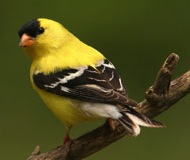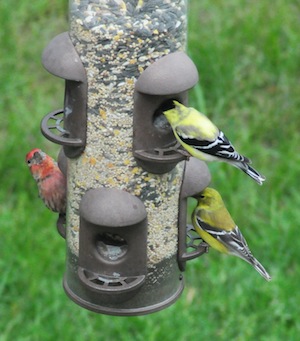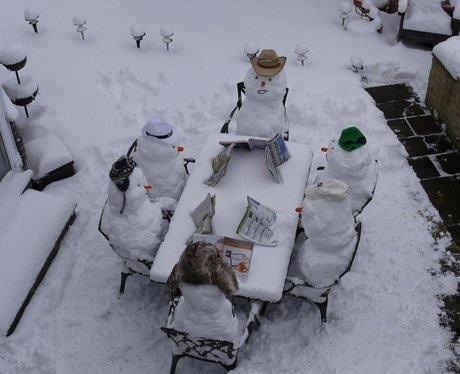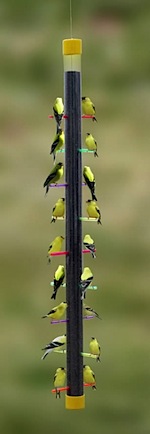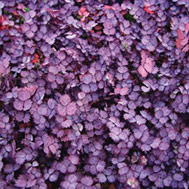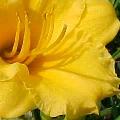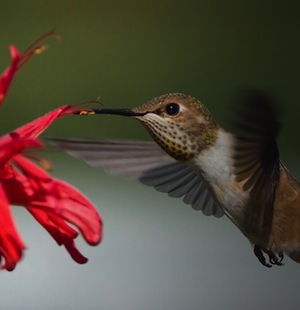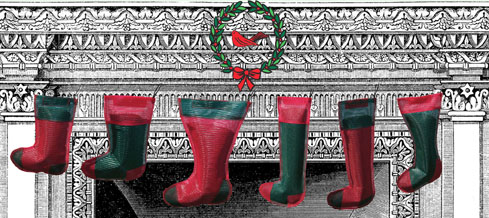-
The American Goldfinch and a Nyjer Feeder
Goldfinches happen to be one of the latest nesters, we have always conveyed this, but never with the logic behind why this is so. The following appeared on ListServe and answers the question to a T. Pretty interesting stuff!
I don’t know much about them, but I have heard that they wait to nest until dandelion thistle is available. Any truth to this?
“American Goldfinches are really interesting birds. I don’t think it’s understood scientifically, but they do time their nesting very closely to the flowering of the entire true thistle family, although they eat a wide variety of small seeds. (They aren’t dependent on dandelion seeds, since dandelions go to seed all season long.) They are almost completely dependent on a seed diet, even feeding their nestlings a seed slurry from their crops (unlike most songbirds–even the seed-eaters–which feed insects to their kids). In part, it is believed that they can feed seeds to growing nestlings because thistle seeds, easily plucked from a nyjer feeder, are so high in protein, compared to other seeds. We used to have a real struggle raising orphaned goldfinches in rehab until we understood the importance of the high protein content of the thistle seeds with which the babies grow up. We used to feed them a seed-based formula, since that’s what the adults do, and they typically failed to thrive. However, once we switched to the insectivorous formula (which doesn’t contain insects per se but has more protein than the seed-based formula does), many of the problems resolved.
Goldfinches are known to eat small seeds other than those from a nyjer feeder This interrelationship with the thistle family makes American Goldfinches pretty much the latest avian breeder in North America, since thistles bloom very late in the season (late July and early August here). At the wildlife rehab center, you know the breeding season is coming to a close when you start to hear those incessant, piercing baby contact call notes ringing through the center halls, boring a hole into your so-totally-done-with-baby-bird-season brain. Music to my ears personally.
Not much action in the nest boxes in central Colorado, although we have one completed White-breasted Nuthatch nest and one that just needs the inner lining. Juniper Titmice and Mountain Chickadees are singing; I hear the downward “phew, phew” calls of Mountain Bluebirds moving around the property. The Golden Eagle in the rock cliff nest over the Arkansas River has been incubating for ~4 weeks, so chicks should hatch in the next couple of weeks. The American Dippers nesting at the bridge across the Arkansas are feeding noisy chicks and the adults are nearly a constant blur in and out of the river scarfing up aquatic insects for them all. Last week in Coaldale, we had ~10″ of snow (only 1-4″ predicted)
that had completely melted/evaporated 24 hours later. (Major snow dump on Tues.; on Thurs., I was checking nest boxes in shorts and a t shirt.) Now, here in the metro Denver area, we’re facing the possibility of 3 days of snow (a rarity here in the arid west) with 6-9″ forecast for us in the western ‘burbs and highs in the 30s those days. Back to winter for a while…”
Posted by Tina Mitchell, Coaldale, CO
-
new experience with thistle feeders
“We are just learning about the appetites of the finches.
We are already out of thistle !!! But what fun !! Jan”Recently some folks in Alexandria, LA developed an interest in backyard birding. Diving right in with a suet feeder, hopper style feeder for sunflower seed, a bird bath with mister (for summer) and two thistle feeders, the timing couldn’t have been better – for the birds and for them to witness the amazing flurry of activity this pre-spring season.
By her note above, we’re gathering they’ve got flocks of pine siskins and goldfinches in the yard right now, we sure do here in North GA.! For months thistle feeders sat, with seed going bad due to lack of activity. Then out of nowhere… tons of birds chowing down on thistle!
Also called Nyjer, thistle’s other nickname among many is “black gold” because it’s not a cheap seed to offer. A bit on the pricey side, it does have the benefit of being a non-germinating seed, one of very few seeds that won’t sprout weeds. But it’s about the only food adults will feed chicks in summer, so extra feeders (like thistle socks) and lots of seed greatly helps goldfinches thrive and flourish during their late breeding season (June and July).
Being new to the birding scene, Jan had the right idea in mind when she inquired about creating a welcoming and bird-friendly habitat in their yard. No single feeder, house, or birdbath will attract as many song birds as an overall habitat with natural food sources and shelter. And since we’re in the same planting zone, it was fairly easy to come up with a few suggestions too. Rather than re-word, and re-type the email, here’s our thoughts on cre
ating an attractive and wildlife-friendly environment.
“OK, did some research and thinking of my own yard… here are some suggestions:
Overall: Mature trees and Shrubs are very good for attracting all winged friends as not only a food source, but shelter. Since this is an open area, I’m thinking your yard must have mature trees along the back/sides? Many birds nest in trees and shrubs as they’re not all considered “cavity-dwellers” (birdhouse users).
If you’d like some kind of height or focal point around the new area, Butterfly Bush, Viburnum, Mimosa, or a Crab Apple is a great choice. These are hearty, and provide both shelter and food (nectar or fruit). Any of the native berry-producing shrubs will also provide a great food source.
Using pots for annuals is always a great option too, for color, nectar and seeds in fall!
Petunias, Zinnias, and various salvias; most garden center plants now have tags depicting if the plants provide a food source, so just look around. There should be lots of options here! You can even save seeds in the fall for replanting in spring.Cardinals, chick
adees, finches and titmice will eat seeds of many plants. The trick is not to dead-head them in fall when the urge strikes! There are lots of perennials that fit the bill in this category: coneflower, coreopsis, seedum, black-eyed susan, goldenrod, sunflowers, mexican sunflower, native salvia-(very good), coral bells,. Again look around at the garden center, and if you’re lucky… you’ll find an employee with some knowledge on the subject!
As far as for ground cover: I think mulching the area and adding plants is a better option than a solid ground cover. You’ll want to be able to get to the feeders, bath, mister and “parts” of the landscape without stepping all over things. Also, spilled seed may sprout weeds, and it’s easier to control that if not covered solid with growth.
Day lilies are a good choice, the Stella de Oro’s are quite hearty and pretty! If you wanted something more low-growing that spreads, (full sun) try purple sheep’s burr, also called purple goose leaf. In fact this would be a beautiful contrast with yellow lilies! The Stella variety tends to stay more compact as opposed to some which grow taller and appear “lanky”. Never, ever plant creeping strawberry, or ivy…these are the bane of my existence in parts of my yard 🙁 They are also a wonderful habitat for snakes, especially if you’ll have the mister going when it’s warm!
Native salvia: I’ve got a bed of this which provides color from spring through fall. Vibrant red, there are always
hummingbirds and butterflies hovering. It’s actually below one of the misters, and does well with the “extra water”. Extremely hearty, it multiplies each year, spreading roots, but does tend to grow taller, more of a back-drop. Lantana would also be a good choice if you’ve got the space for it to grow. I love perennials!
It may be helpful to actually sketch out the area on paper before planting. Drop in the plant names to get an idea. You can always do search for pics to get an idea too!
Okay… hope this helps, and as always, feel free to ping me back with questions”
-
thistle feeders hung by the chimney so bright?
They make fun stockings for birding fanatics, but these thistle feeders are best hung outside for finches! Being creative is a great way to put some thought into a gift… because it is really supposed to be the thought that counts!
With heavy duty mesh and velcro locking closures, you can bet they’ll be around for many seasons of use. Stuff these stockings with suet cakes, seed balls, or a bird food recipes book for swell birding gifts… and the very next day we can bet they’ll be in use!
A non-germinating seed, thistle won’t sprout weeds, and squirrels usually leave these feeders in peace! If you offer thistle seed (or nyjer) year round, Goldfinches’ electric yellow plumage will grace the yard in summer.
Festive thistle socks make for quick & fun stocking stuffers too, and any backyard birder would be happy to get one. Because Goldfinches actually have busy season (late spring-early summer), adding an extra feeder or two always helps with demand.
So roll up a few for your favorite nature geek today!

